Overtourism: Did Japan Become a Victim of its Own Success?
“Overtourism in Japan has led the locals to coin a new phrase: kankō kōgai, or tourism pollution.” ~ Alyse.
What caused overtourism in Japan? How has it affected the local way of life?
Let’s talk about an elephant in the room. In recent years I’ve been questioning if people were beginning to travel backwards… By backwards I mean, would you visit a place to “say you’ve been” without actually knowing what’s there? Are you happy to be blissfully unaware of a culture different to your own? Unfamiliar with the awe-inspiring things to see and do at your destination?
Well, many travellers to Japan seemed to be planning their travels that way up until early 2020. After all, Japan was THE destination of the moment! You just needed to take a look at the images floating around on social media platforms to see this and the hype it created, urging more people to visit.
I first published this article in June 2018 before other major publications caught on to this worrying trend, and have updated it since. The issues I discuss below are not exclusive to the Land of the Rising Sun, but I wanted to highlight some major changes to tourism in Japan I’ve seen over the past decade.
After my multiple visits to Japan over the years, my observations have made it clear that we need more visitors to understand the traits of responsible tourism and how to avoid looking like a tourist to help curb some problems.
If you’re interested in learning how tourism pollution affected Japan, what happened when tourists stopped coming when Japan’s borders closed for 2.5 years, and how you can help avoid mistakes of the past when visiting in the future, read on for more!
This post contains affiliate links, at no extra cost to you. I may earn a small commission if you click through and make a purchase.
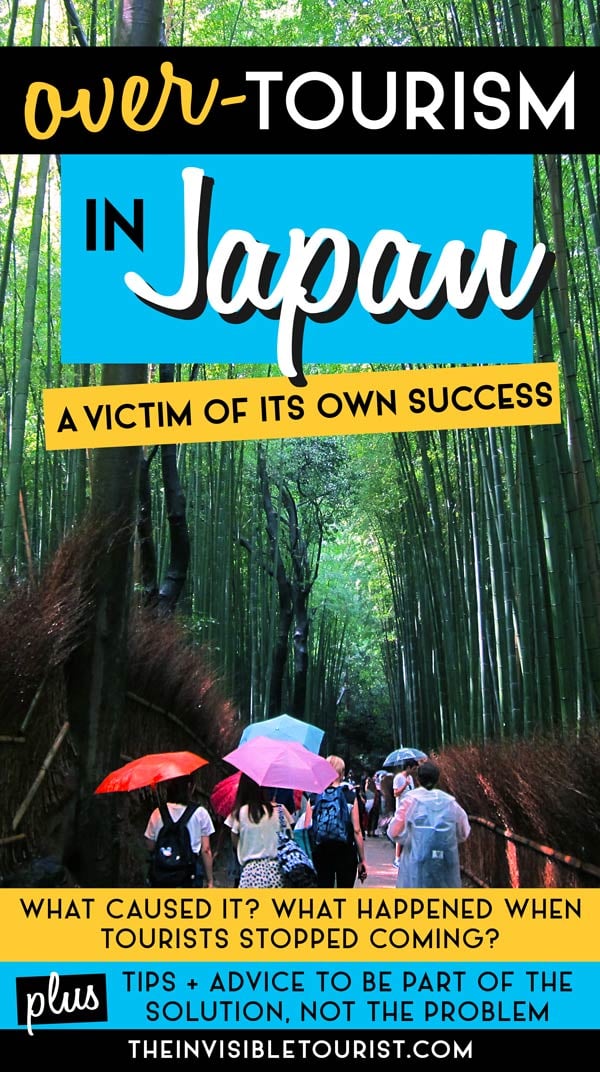
Why visit Japan?
In 2018, I noticed a disturbing trend sweeping online travel groups and forums: People were booking flights to Japan unaware of exactly WHY they want to go. What is Japan famous for, anyway?
Questions popping up in these groups frequently included, “Booked tickets! What things can I do there?” and “Going next week, what cities do I visit?” and this had me quite concerned. It seemed a bit backwards, considering the things to do and places to stay would normally be the huge drawcards to a destination.
I’m aware this is going to sound ironic coming from someone who shares itineraries to help others travel, but I do worry about overtourism in Japan.
The issue here is if these spontaneous ticket-bookers weren’t aware of simplistic things like attractions to see at their destination but are just going to say “I’ve been there!”, how can they be expected to know (or care) about more complex behaviours like customs and etiquette in a country that hold these things so dear?

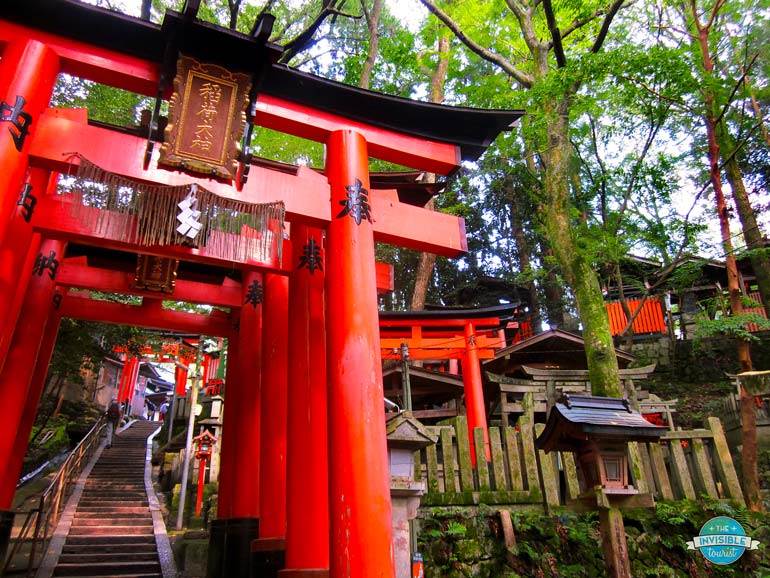
Concerns about overtourism in Japan
Overtourism in Japan has led the locals to coin a new phrase: kankō kōgai, or tourism pollution. This revelation spills over into me asking more questions:
Will Tokyo be the next Rome? Streets littered with rubbish and noisy tourists drowning out the local culture? A false backdrop to the famous buildings and structures that proudly adorn the streets and alleyways as a marker to their ancestors’ ingenuity, power and successes?
Will Kyoto be the next Taj Mahal? The peace and tranquility of this 17th century wonder stomped out by the busy hustle and bustle of large groups of people, the serenity and ambiance punctured by selfie-sticks?
It is no secret that Japan is a fiercely mono-ethnic nation, with incredibly low levels of immigration and external cultural influence. In response to an ageing population they are planning to use robots to fulfil the gaps in the labour market, not by bringing in outsiders.
Whether you agree or disagree with this general sentiment is not relevant, we can all agree on the fact that Japan has an extremely unique and rich cultural heritage and they are in no hurry to water this down, or blend it in any way.
It is also obvious that tourists are fascinated by this culture (despite not having much of an understanding about it) and flocked to the island nation in their millions. In 2014, Japan received over 13 million inbound visitors. That number skyrocketed to almost 32 million just five years later.
By 2020, the Japanese government hoped to welcome 40 million visitors for the Tokyo Olympics – that’s over 25% more tourists than the 28 million that visited the island nation in 2017 alone.
From what I can see Japan doesn’t need more tourists, it needs more mindful tourists.
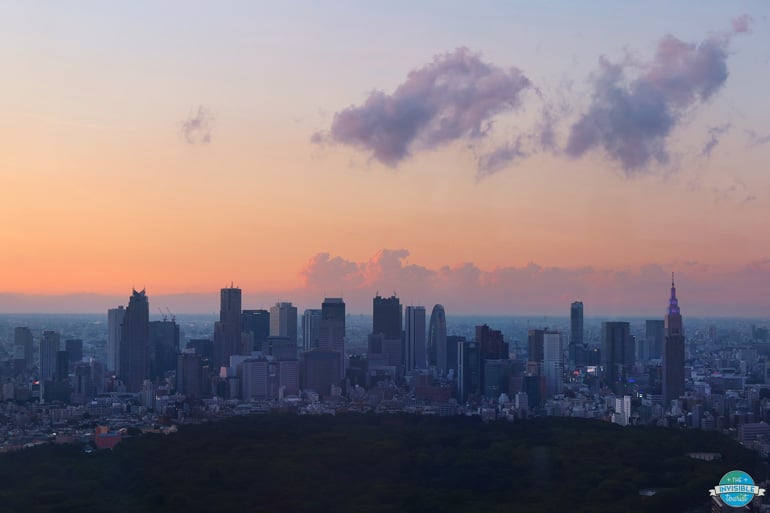
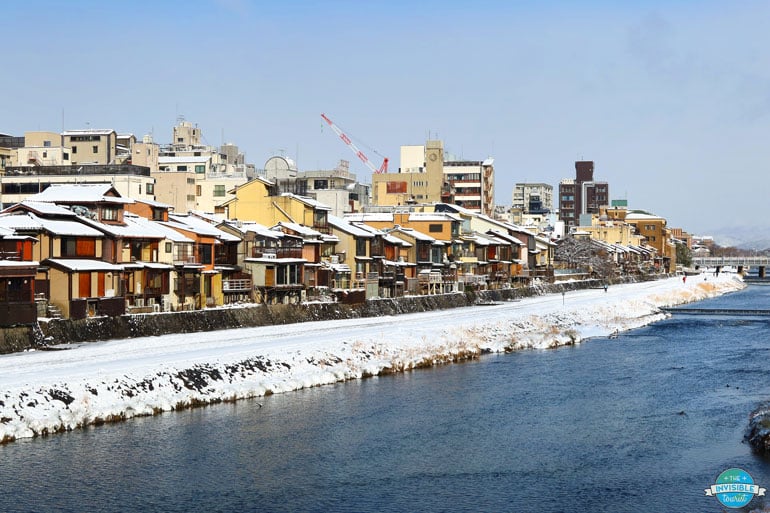
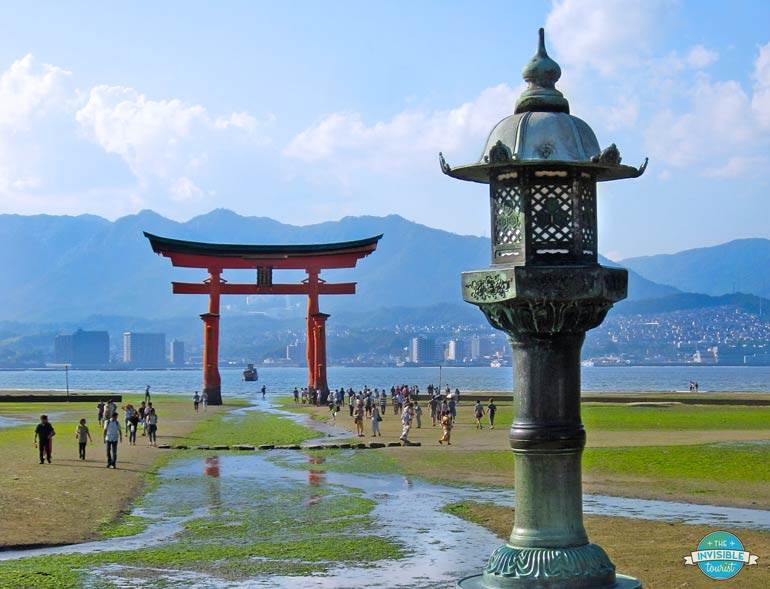
READ MORE:
3 Weeks in Japan Itinerary: Sights & Culture Off the Beaten Track
Why You Shouldn’t Use Airbnb: 8 Troubling Issues You Didn’t Know
Ethical Alternatives to Airbnb for Responsible Tourists
Examples of tourism pollution in Japan
With the influx of visitors to Japan since 2015, it became clear that a majority of tourists had no idea or respect for the local customs. It seemed many issues stemmed from tourists being disrespectful in order to gain validation on social media, which contributed to serious issues such as tourism pollution.
For instance, let’s look at some negative impacts of tourism in Japan.
Overtourism in Kyoto
- Maiko (geishas in training) were harassed by tourists for selfies whilst they were on their way to work, leaving them in tears.
- The wonderful Bamboo Groves in Arashiyama, a UNESCO World Heritage site, were defaced by tourists etching their names into the bamboo, much like leaving their mark akin to love locks in Paris.
- Restaurant owners were left disappointed and annoyed with social media hype. Inconsiderate tourists walked into restaurants just to take photos to post online, then left without ordering anything.
- Busloads of tourists visited Kyoto only for a day trip. During my summer trip to Japan in 2019, I noticed these twelve coaches parked in the image below near the small paved street of Sannenzaka. There is enough parking here for 42 coaches, so if we say 42 coaches times 50 people in each = 2,100 day trippers crammed into this relatively compact area of Kyoto at any given time (and that’s not including the spaces for regular cars and their passengers). These centuries-old streets were not designed to cope with that many people at once. Tourists were too busy trying to shuffle past one another that no one was venturing into the local businesses lined along the street.

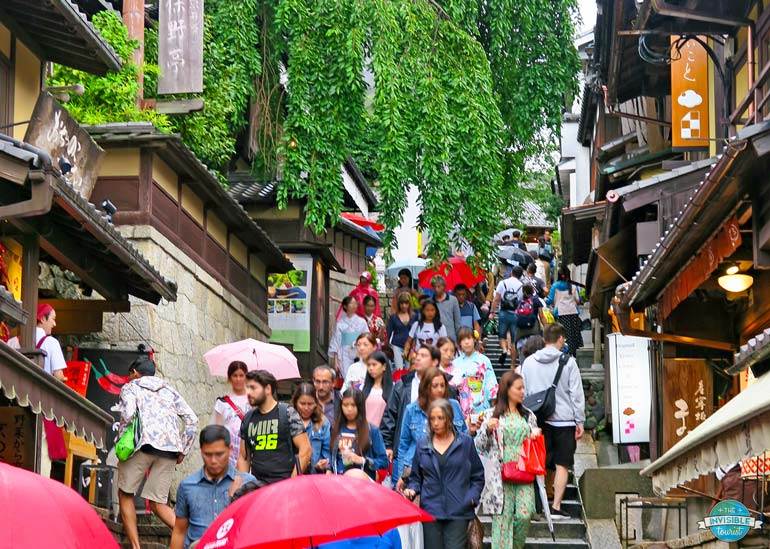
- Another controversial event that happened in Kyoto was the building of the large hotel chain, Park Hyatt, suites in this area. 70 rooms became available from December 2019. During cherry blossom season, these rooms with a view over Gion were set to start from USD 2,000 per night. Sure, this created local construction jobs and at least the suites are trying to keep in with the traditional buildings surrounding them. But, can this area handle even more tourists?
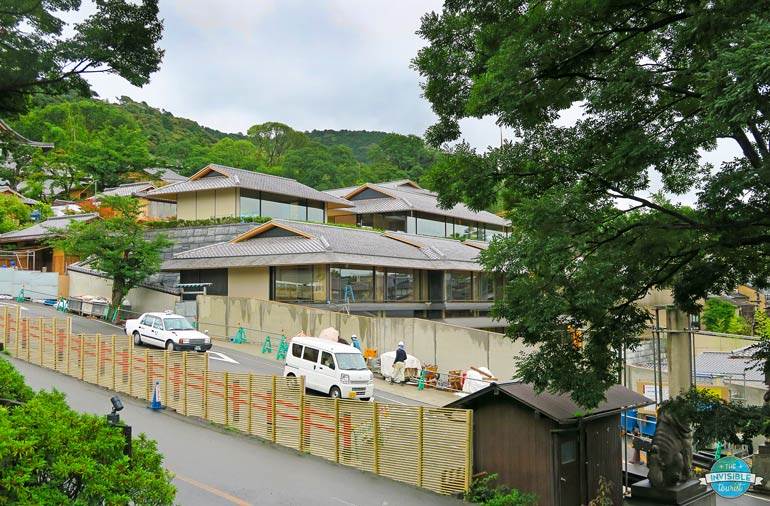
Overtourism issues in other areas of Japan
- Tourists ended up nursing wounds from disgruntled sacred deer in locations like Nara and Miyajima from taunting them with food in order to get a selfie with them, as well as leaving foodscraps lying around that could make deer sick. One deer was found dead with four kilograms of plastic in its stomach.
- In Biei, Hokkaido, tourists trespassed on farmland and trampled on crops to get Instagram-worthy photos. One such popular spot was the famous Philosophy Tree. In an effort to deter tourists from trespassing on his property, one farmer was forced to cut down the tree in 2016. This didn’t stopped tourists from trespassing on farmland to find it, however. Sometimes, farmers could not use their tractors in the farming lanes due to illegally parked tourist cars.
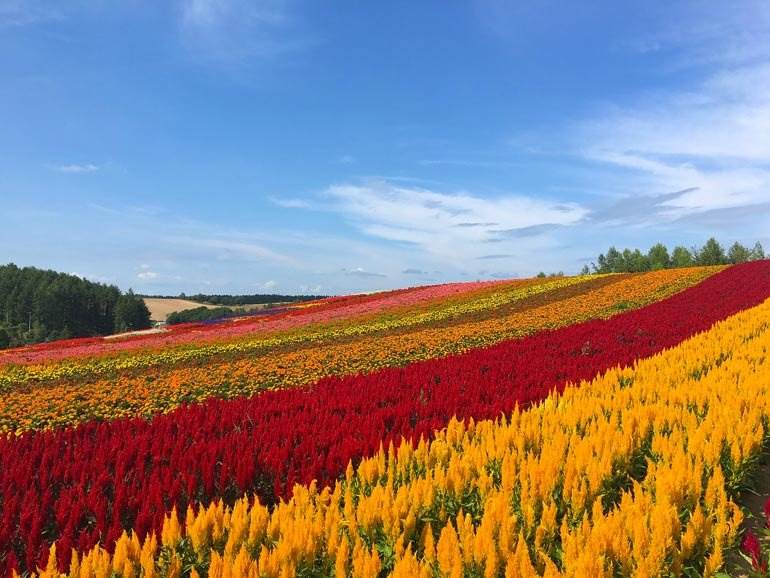
- In June 2018, the Japanese government resorted to tightly clamping down on illegal Airbnb and similar unregulated homestay accommodations or minpaku across the country in response to an overwhelming number of complaints. These new laws aim to help ease the negative impacts on communities from the hoards of tourists disturbing locals at all hours in unregulated accommodation in unzoned areas.
- In Kamakura, one of the more popular day trips from Tokyo, about 50,000 – 60,000 tourists would visit Konmachi-dori shopping street each day (it’s only 350 metres long!) This led to crammed people eating and walking on the streets (a cultural faux pas Japan), leaving rubbish behind. Large tour buses would arrive at the Great Buddha, creating huge crowds and the local infrastructure such as the electric railway was struggling to cope. I leant this during my Kamakura day trip with a local guide.
- In Nagasaki, the priest of Watatsumi Shrine had become so fed up with the sharp increase in vandalism, theft of precious talismens and overall disrespectful behaviour, he announced a blanket ban on all foreign tourists. Receiving 30-40 large tour buses each day meant the priest was also subjected to aggression from tour guides when he asked large groups to not to block the sacred entryway for local worshippers. Thankfully I saw nothing like this during my 2 days in Nagasaki.
- At Shirakawa-go, another UNESCO World Heritage site, illegal parking in the small and remote village increased rapidly due to increasing tourist numbers.
- Overall throughout Japan, there was a boom in young tourists from Asia visiting locations featured in popular anime, wanting to capture shots for themselves.
- At one of Japan’s most visited attractions and another UNESCO World Heritage site, the Grand Torii Gate at Miyajima (pictured in the tweet below), came under threat. Tourists rammed coins into cracks forming in the timber for good luck, which over time would expand and compromise the stability of the structure. From June 2019 – December 2022, the Torii went under renovation work to repaint and repair the damage.
鳥居が倒壊する、おそれがあるので…RTwitterお願いします(^_^;)厳島に呼ばれた意味が、わかりました(^_^;)この硬貨をみてください(^_^;)ヒビにいれたら…サラにヒビがはいり…最悪倒壊します(^_^;)世界遺産の鳥居がなくなったらイヤになりますよ(^_^;)神社は、テーマパークでは、ありませんよ(^_^;) pic.twitter.com/JEC4jNLG1o
— 氣功師 黄龍 龍水 (@riyusuisuiriyu) February 3, 2018
Seriously. Rude much.
I could go on and on but by now I’m sure you understand what I’m getting at here. It is SO crucial to know the do’s and don’ts when visiting Japan to avoid contributing to the above problems.
What on Earth are these tourists doing except destroying the very things they love? Do they not realise their individual actions do have a huge impact?

READ MORE:
Here’s How to Spend 2 Weeks in Japan as an Invisible Tourist
Must-Have Snacks from Japan You Can’t Return Home Without
What happened when tourists stopped coming to Japan?
As we’ve examined above, overtourism can cause a number of issues for locals and significant attractions. But what happens when the tourists stop coming and the opposite – undertourism – occurs?
The below list doesn’t take into account the many small businesses who have faced hardship and involuntarily closed. While the following closures of well-known businesses may not be solely due to a lack of tourists, they have unfortunately all occurred since March 2020.
Closures of well-known businesses in Tokyo
- MariCar (StreetCart), a lack of tourists along with a lawsuit from Nintendo and a failed crowdfunding campaign forced the business to close (July 2020). But don’t worry, an official version will be at the new Super Nintendo World in Universal Studios, Osaka.
- SEGA Building Two, the popular red building a symbol of Akihabara (August 2020). The iconic “SEGA” signs were removed in April 2022.
- LABI Higashiguchi Building, a popular electronic department store in Shinjuku (October 2020).
- Silk Hat Video Game Arcade, Ikebukuro (January 2021).
- Kawaii Monster Cafe, Harajuku (February 2021).
- Robot Restaurant, Shinjuku – There has been no official announcement from the company of permanent closure, however locals began speculating when the iconic signage was removed from the front entrance (May 2021). However in June 2022, I spoke to a manager of the Robot Restaurant during my trip and he mentioned they are hoping to reopen in 2023.
- Odiaba Oedo Onsen Monogatari, a hot spring theme park (June 2021).
Other impacts due to a lack of tourists throughout Japan
- The sacred deer of Nara who were used to being fed crackers by tourists began to look malnourished and wandered north outside of Nara Deer Park in search of food (October 2020). However, with the absence of tourists and an easy food source, deer began to learn how to forage again and return to their natural nocturnal habits according to a report.
- Kyoto’s Maiko (trainee geisha) experienced hard times due to lack of gatherings and clients, forcing some girls to quit (June 2021).
- Beloved Studio Ghibli Museum in Tokyo asked for donations to help stay afloat (July 2021).
- Mayor of Kyoto announced Kyoto will face bankruptcy in a few years due to the extended lack of tourism (August 2021).
The negative impacts of a lack of tourists is beyond unfortunate for everyone. So, now international tourism has resumed in Japan, is there a way for visitors to strike a balance and avoid overtourism issues in future?
How to not look like a tourist in Japan: The bigger picture
Some people understand and respect the need to maintain the natural beauty of locations. This is why we have seen such a surge in eco-tourism in recent years. But what about the beauty and significance of the culture of a location? Have we been thinking enough about the impact that tourism has on this?
If we don’t, we run the risk of destroying the very reason people will want to visit (a direct parallel to the perils that eco-tourism strives to avoid).
This insight that I’ve had – that respecting cultural customs, peoples and communities, and in essence behaving like an “Invisible Tourist,” was one of the main drivers behind me starting this blog.
Seeing what unfolded in Japan was heartbreaking, as Japanese people have the highest level of respect towards one another and the natural world. Respect is beautifully intertwined within all aspects of their lives.
As a child I remember learning, “look but don’t touch” when exploring ancient stalagmites in a cave. “But Dad, what does it matter if I just touch it once?” I recall asking. “If everyone did that, there would be no stalagmite for you to look at now” he replied.
This is a lesson I have tried to apply to the way we approach tourism in general – blend in, show respect, learn their language (to the extent you can) and understand the way the people there live. If we do that, we won’t destroy it for the next generation.
This why I am super passionate about being “invisible” and encouraging others to do so, much like the “Leave No Trace” ethics that promote conservation when travelling outdoors. I’ve even dedicated an entire article about how we can still travel and avoid contributing to overtourism issues to try and help spread the word about sustainable travel.
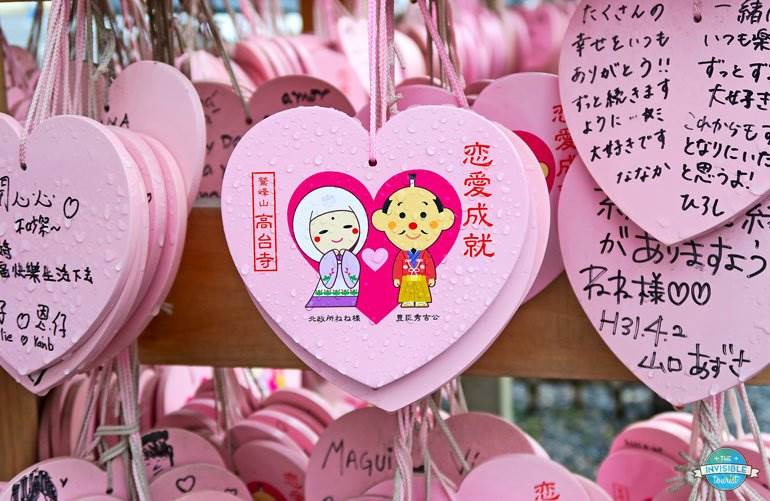
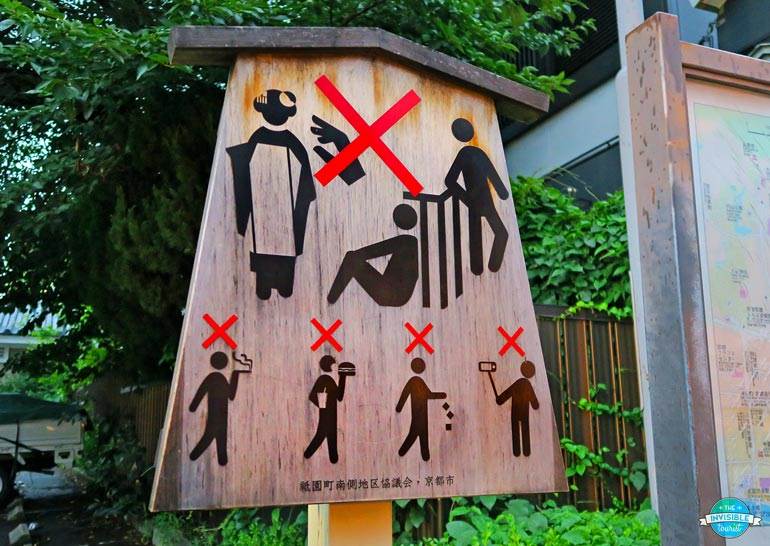
READ MORE:
Amazing Kyoto Hidden Gems You Won’t Want to Miss
Ways to avoid contributing to overtourism in Japan
I’m in no way suggesting that everyone should just stay home and never bother seeing our wonderful world, as this will not really benefit anyone.
We can, however, be more mindful about how (and why) we travel and try to do our absolute best to minimise our tourist footprint on local communities of the places we visit. Here are a few ways:
- Just be prepared and research, research, research! Know what vibrant cities there are to visit at a destination and how to get around in each. Also note the cheapest option may not be the most sustainable.
- Learn about expectations regarding local Japanese etiquette and the significance of attractions to make our visits more meaningful. There isn’t much point getting a photo at a temple if we don’t know much about its history and why it’s an important part of Japanese culture.
- Get out of the main touristy areas! Wander off the beaten path, discover some hidden gems, get lost in some backstreets. There’s much more to a destination than what’s limited to the photos we see on social media. This also helps to dilute tourists from the most heavily visited areas. For Japan, this means exploring beyond the usual Tokyo-Kyoto-Osaka route.
- Avoid travelling as part of large groups on a package tour. There is anonymity in travelling in this way where large groups of 50+ people aren’t held accountable for their negative impacts. If you want to be part of a tour, consider companies such as InsideJapan who travel in small, sustainable groups of no more than 14 people. Alternatively, join a small local tour that specialises in Japanese cultural experiences in various cities such as Arigato Japan Food Tours and MagicalTrip.
- Give back to locals instead of making their lives more difficult, like avoiding Airbnbs and enjoying some cultural experiences to better understand their way of life.
- Travel during the off-peak periods, both daily and seasonally. Go visit during summer in Japan or winter in Japan as I have, there are fewer crowds! Use the metro and public transport outside of rush hour each day if you can, and avoid travelling during major holidays like Golden Week.
- Spend longer at your destination. I realise this sounds counter-intuitive, but by spreading your travels out over a few days rather than rushing around in a day is a more sustainable, enjoyable way to see a destination. This means you’ll be able to visit the popular tourist spots during off-peak times to lessen negative impacts.
- And, it’s not necessary to share EVERYTHING we do on social media as it happens. Be in the moment. Sometimes it’s about the memories we make that we keep to ourselves that are the best ones!
- My full guide on how to avoid contributing to overtourism anywhere is also full of ideas to ease the burden. I’ve also literally written the book about ways you can unlock your hidden power as a tourist to use for further good. Includes my personal blueprint for planning a stress-free trip every time, too!
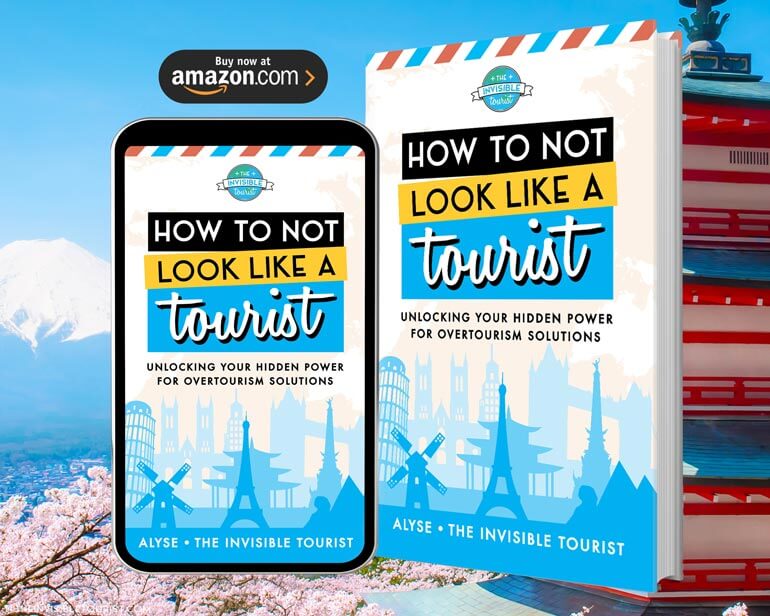
If people spent as much time researching their travels as they did posting endlessly on social media about what they ate for lunch or without really knowing about what it is they’re sharing, tourism pollution would be on its way to being a thing of the past.
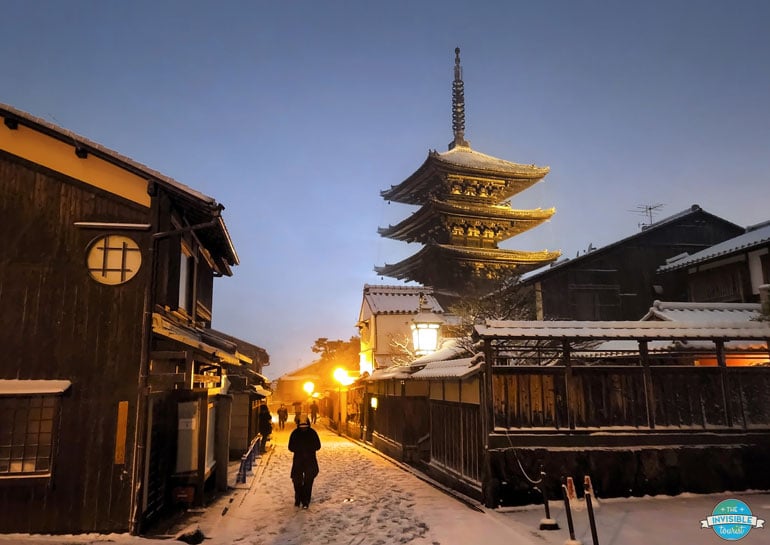

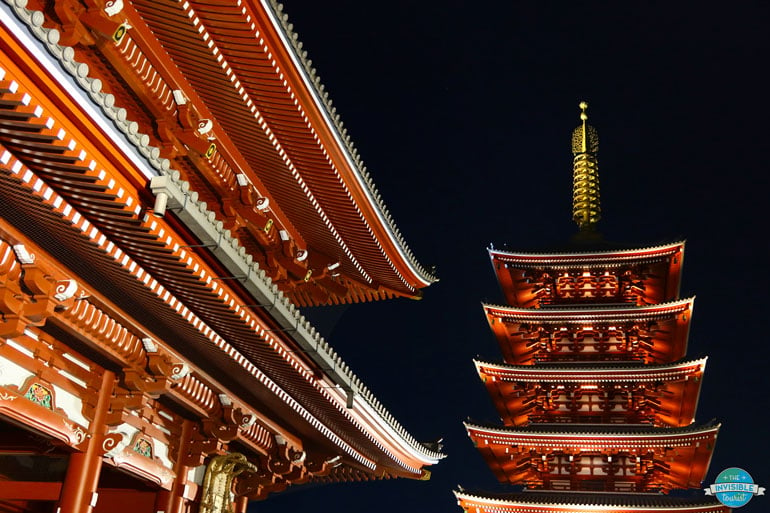
Travelling opens our minds to new ideas, cultures, beliefs, and ways of doing things. In saying that, what is acceptable to do at home may not be acceptable to do in a foreign place. Even something like walking the streets of Tokyo chowing down on some sushi will be frowned upon.
Remember when travelling in Japan (or anywhere), we are guests and it’s important to respect our host and their home. Be a rebel by travelling in a way the majority aren’t! It’s all about having respect and being prepared before you go.
What are your thoughts on this? Is Japan’s strong sense of cultural identity slowly being eroded away by overtourism? Have you seen tourists behaving badly in Japan or elsewhere? Is tourism pollution affecting your local community? Let me know!
If you’d like to learn how to be an Invisible Tourist in Japan (or anywhere in the world!), take a look at my travel guides and itineraries that are tailored to specifically to help you do so 🙂
Help to spread the word by sharing this with anyone you know visiting Japan and join me on Facebook, Pinterest, TikTok and Instagram for more!
Until next time,

Read my Tokyo Treat review and get popular Japanese snacks delivered here, or read my Sakuraco review and get traditional Japanese sweets delivered here!
Like it? Pin it! 📌
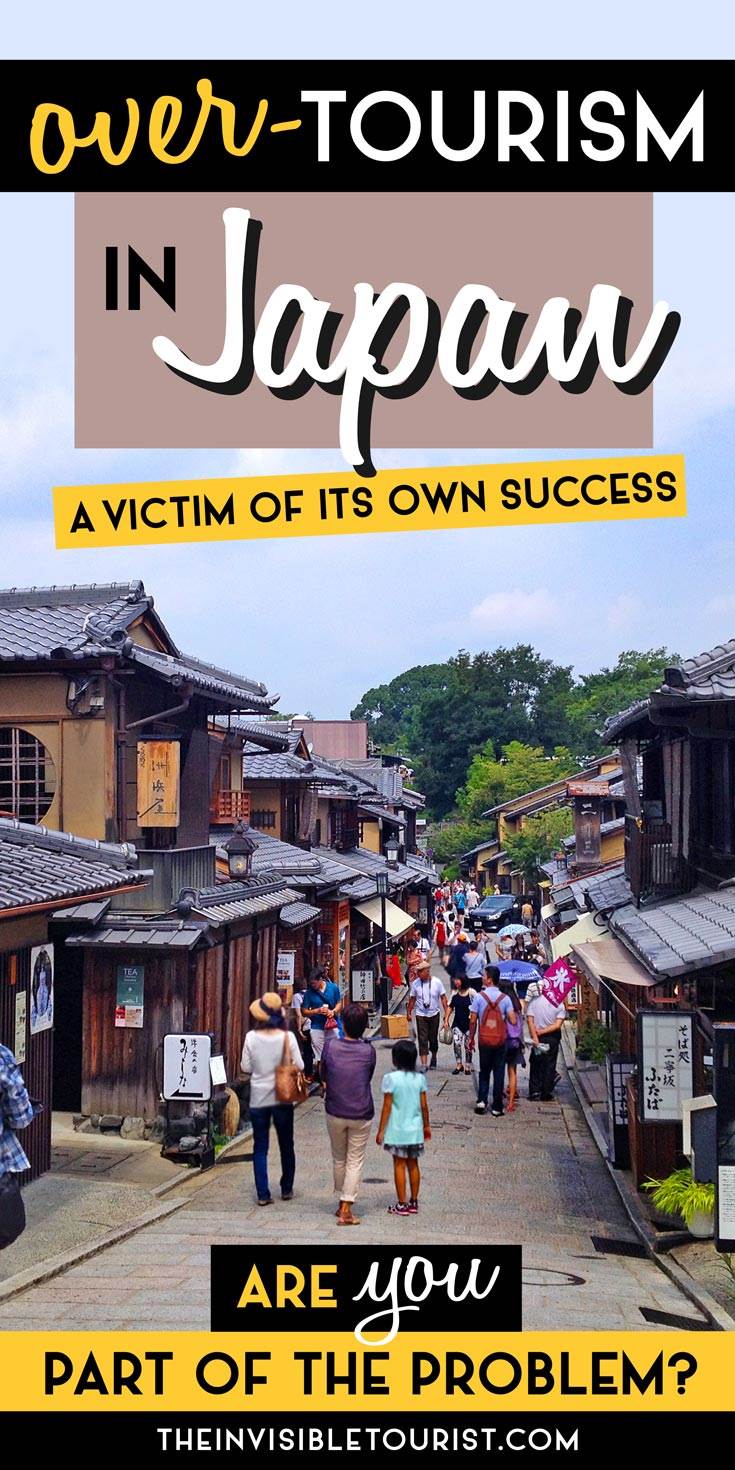
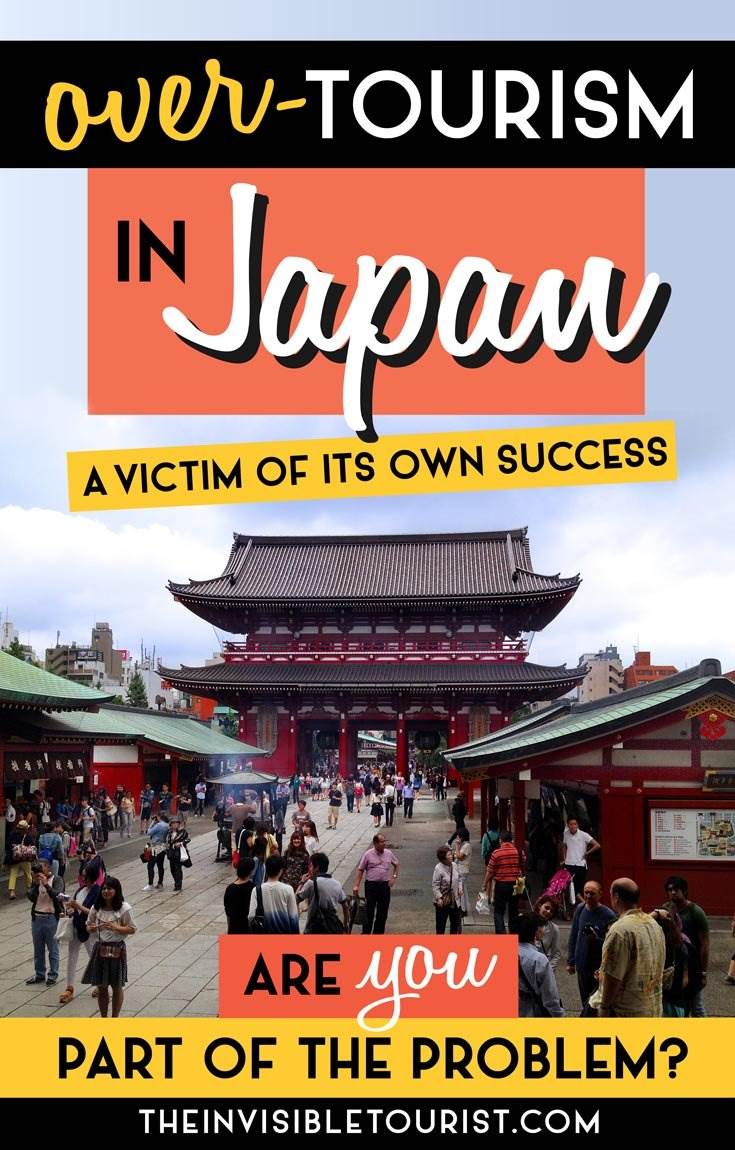
This guide to overtourism in Japan may contain affiliate links, at no extra cost to you. I may make a commission if you decide to make a purchase through these links and if you do, thanks for your support! This goes towards the costs of running my blog so I can keep my content free for you. As always, I only recommend products and services that I genuinely love and use myself!

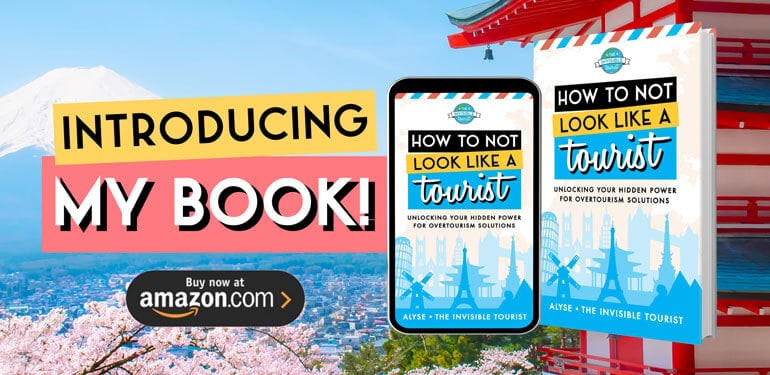
Hi Alyse, I came across your blog doing research on an upcoming trip to Japan next year. Yes, RESEARCH for a holiday!!
This will be our first stay there, a long awaited trip I have dreamed of for 20 years. Actually, we did have 2 day stopover in Tokyo in the late 90s, got completely lost, overwhelmed by the crowds ( all locals, no tourists back then…) but loved the energy and the culture and vowed to return one day for a longer and hopefully more meaningful visit.
We have travelled all over the world in our lives, most of it cruising on our own boat ( I know, lucky we were! ) and have been fortunate to explore iconic destinations and discover out of the way places, before mass tourism hit them. For me, travel is about the discovery of another culture, landscape and language. My favourite memories are of moments shared with locals either over a meal, in a playground with our kids paying together, or on small tours where you get a chance to chat wth your guide about their own lives…I realise not everyone has the time or the resources to travel that way, but respect of the local customs and people surely is a universal thing, no?
Anyway, love your articles and your blogs, I look forward to reading your advice and do some more planning: my teenage daughter is all into cherry blossoms, food and anime, I want to eat my way thru Japan, hike amongst ancient forests and visit a temple or 2, while my husband is happy to go ” as long as he’s kept away from the crowds” ! Challenge accepted.
Haha I’m so glad to hear you enjoy doing research before a holiday as well, voahangy! You’re also so fortunate to have experienced many cities before mass tourism took over. Thankfully I first saw much of Western Europe before this happened as well. I always notice big changes in Europe from one visit to the next.
I 100% agree the memories you mention are some of the best. We would think being respectful of locals would be a universally known thing… Unfortunately this isn’t the case anymore, hence why I wrote this article!
Thanks so much for your lovely compliment about my blog and I’m so glad you enjoy reading 🙂 I hope you have an enjoyable time in Japan when you visit next year with your family!
thank you for this article, and I agree with other people comments that we could find this issues in other country too. I am from Bali and sometime I hear a news that the foreigner / tourist do crimes. robbing, hacking, and do some crazy things in the road. and myself as local people feel scared to visit tourism spot at night.
I visit Japan once, 3 years ago. I visit Osaka and Kyoto for company trip. 1st and 2nd day I visit tourism spots area since itinerary decided by company. there was so packed, I got lost so many times. but on 3rd day, I strolled around with my Japanese friends and visited Arashiyama. as per your mentioned in article, I saw Indonesian name was written in the bamboo, I feel so ashamed, and yes in Gion I saw some people followed the Maiko.
As the same foreigner, I feel so ashamed and actually surprised at the same time.
well, everyone who know Japan must know that Japan is well-knows as discipline country, so I got surprise that the tourist do those horrible thing in Japan. I always think that If we travel to other country we have to follow their culture and law, right. If the people in the country we visit are discipline, we have to discipline too, right. I just don’t understand.
Actually, I have plan to continue my study to Japan by scholarship (Hope I got accepted), and I have plan to study about tourist behavior, it just I want to know how the local feel about it.
I wonder if they feel the same as I feel in my area.
sorry for my bad English…
Hi Yeni, firstly no need to apologise as your English is brilliant!
Yes, in recent years Bali has become a tourist hotspot on a major scale too (us Aussies have always travelled there as it’s somewhat nearby) but now it seems a more international audience has picked up on Bali as well. That’s so awful you no longer feel safe in some places at night, so sorry to hear that.
It’s always very surprising to see what perils mass tourism is bringing to Japan, unfortunately (and other places as well). It really makes you wonder what goes through the minds of some people. Don’t they care enough about the place they visit to treat it as they would their own home? I don’t understand either and I hope we can change that through spreading awareness.
Best of luck with your studies, studying tourist behaviour sounds very interesting! Thanks for your comment 🙂
Great article! On my most recent trip to Japan, there was a group of tourists on the train during rush hour, half of them came in one door of the car, and half through the other. They were yelling back and forth to each other about where to hop off, as the train went. My sister and I seemed to slink further and further away, afraid others might think we were with them. Super embarrassing, even when it had nothing to do with us.
I had a 5 year gap between my most recent trip and the one before, and the more recent one, I saw way more idiotic tourists that made me go “what in the world are they thinking!?”. My hope is that next time I go, it won’t be as bad. Though I was in Tokyo during peak Sakura week, so it was tourist overload, anyway :/ next time I want to try a different time of year!
Thank you for spreading awareness like this 🙂
Oh I hear you, Tara! It is so embarrassing for us respectful visitors when others are loud and inconsiderate 🙁
I can assure you the “un-invisibles” (as I like to call them) are there year-round, unfortunately. My most recent visit was during summer, the best time to go for fewer crowds, but they still manage to stand out. There just aren’t as many during summer, thankfully! Thanks so much for your comment and I hope you don’t encounter such rude behaviour during your future visits to Japan!
I am an American student at Waseda University in Tokyo, I think this article written in English is targeting the wrong people. There are very few Western tourists coming to Japan compared to neighboring countries. Here are a few facts about tourism in Japan from Asia Nikkei Review. Mainland China was the No. 1 source of visitors to Japan last year, accounting for 7.35 million, or 25.6% of the total. South Koreans were close behind at 7.14 million, or 24.8%. Back in 2007, only 942,439 Chinese tourists came to Japan. But over the next decade, the figure soared by 680.5%. Traffic from Taiwan and Hong Kong was also brisk in 2017: The former accounted for 4.56 million visitors, or 15.9%, while the tally from the latter came to 2.23 million, or 7.7%. In terms of sheer growth rate from 2007 to 2017, Vietnam actually led the pack, with an 868% increase over 10 years. Arrivals from Thailand surged 489.3%, while those from Indonesia jumped 448.7%. Many of these neighbors of Japan simply don’t have enough money to pay for expensive hotels and restaurants. They come on a discount tour group because it’s their only chance to come to Japan at a price they can afford. It is not reasonable to expect them to pay high prices for tradition Japanese hotels. They would if they could, but the next best thing they can do is take pictures and then they are criticized for not spending enough money. Japan is very expensive for surrounding countries, but that doesn’t mean poor people don’t have the right to see it too. The tours don’t take them outside the main routes, it’s not that they don’t want to see the countryside. They have no choice.
Thanks for your comment, Alyssa. You’re right in saying this article is not targeting the huge increase in visitors to Japan from neighbouring countries. While I understand and agree with what you’re saying, with my limited resources I can only try to spread my message to my existing audience (who largely come from Western countries). I’ve seen first hand the rise in Korean, Chinese, Vietnamese etc visitors to Japan and I believe all visitors should behave as respectful as possible to their host country, regardless of their financial background 🙂
Hi, I was wondering if these images are all yours, I’m writing an essay for school and i need this information for the bibliography. 🙂
Hi Abbey, yes, all images with my logo watermarked in the bottom right corner are mine that I took myself and are protected by copyright. The image of Biei is from a royalty-free stock image website and I have included the appropriate credit beneath it 🙂
A huge thank you for this article. It’s time we address the elephant in the room, tourism in Japan has become unbearable.
I’ve been going to Japan yearly since 2006 and the evolution of tourism, especially the last 5 years is frightening. I remember back in the days, the first time I went there, people reacted like if I was going to the moon when I told them I was going to visit my dream place, Japan. To them it felt uncanny. Going to Japan from Europe was long, expensive, and complicated (there were no websites like Booking, etc, and most hotels did not use english). When I got there, I was surprised by how few westerners were there. The ones I met were all either working or studying there, or were like us, tourists finally getting to visit their dream place, conscient of how lucky we were. Basically, it needed involvement. You were not going there out of the blue.
Everything was great until Fukushima, when japanese autorities decided to promote and encourage tourism to counterbalance the effects of the disaster. The plane tickets also became much cheaper at that time (not only for Japan, but also globally). Then it really started shifting around 2015 with tourist numbers increasing even more every year. 2018 has been a real disaster. As you explained brillantly in the article, now people just go there because it’s the place to be, to get their bloody pictures for Instagram or for their crappy Youtube videos, this is heartbreaking. They are all over the place now, not giving a single damn about the locals, their culture, their everyday life, no respect at all. Being fluent in Japanese, I often feel ashamed towards the locals for the behaviour of western tourists, because for them we are all the same.
All this thing is getting nonsense. The best illustration is western instagrammers/bloggers/whatever in Kyoto taking pictures of Chinese and Korean tourists dressed in “traditionnal” yukatas and posting them on social media like they caught a rare glimpse of authentic Japan. Pathetic.
Speaking of Chinese tourists, talk about another disaster. They are now all over the place, everywhere. They are loud,rude, uneducated, and have no notion of how to travel and behave whatsoever. They just pour out of their coaches like locusts, raid the places, then go back to the buses heading to their next stop. Last spring I was in Osaka and had to stop to buy something in Dotonbori’s Bic-Camera. The whole shop (all 9 levels) was full with only Chinese tourists. The only Japanese people there were the staff. I’m unfortunately not exaggerating.
All this is just madness. I don’t think the country can take it much longer and I hope the trend will decline after the Olympics. For the moment the population doesn’t say anything because it brings a lot of money in a country where growth is now more of a fantasy, but polls show that a vast majority of the population is against mass tourism (especially from mainland China). For the moment the upcoming Olympics are federating the population under national pride, but once it will be all over I wouldn’t be surprised to see some well needed backlash.
Thank your for your quality write up, from a fellow invisible tourist !
Hi Ebisu,
On reading your comment I found myself saying “EXACTLY” out loud on a number of occasions! I couldn’t agree more about everything you have stated here. You are so right about how things used to be back in the early 2000’s. Travelling required a lot of effort, research and money, which meant travellers who put in the hard yards appreciated these unique experiences. Sometimes it would be a once-in-a-lifetime trip so it was taken seriously.
These days travel is much more accessible and it seems the “barrier to entry” has been lowered, so to speak . Cheap flights and accommodation are ample, meaning instead of travelling every few years, many people now travel a few times a year. You don’t even need to research where to go, all you need is a smartphone with GPS and an Instagram geotagged location and you can visit, too! It’s almost too easy and the lack of prior planning and research results in people thinking the kimono-dressed tourists are real maiko, as you say.
With the record numbers of foreign tourists accessing the country without knowing correct etiquette, I really think the Japanese Government or National Tourism Board needs to do something like hand out pamphlets on all inbound flights to Japan. These could briefly explain some basic etiquette so tourists can’t plead ignorance, and maybe at Immigration they need to sign something to say they read and understand the booklet. These people need to be forced to become aware of the issues because they are completely oblivious. Things can’t go on as they are!
Like you, I truly hope things can be turned around so tourism in Japan is beneficial for more than just the bottom line. Thanks very much for your thoughtful comment 😊
A well- written article and you and commenters have made a number of important points. I’ve lived here both before the tourist hordes (latter half of the 1990s) and now for another 6 years after tourism really began to become an issue after 2013. What’s always forgotten is that cities are places where people live, work, and study. If they can’t be bothered to research where to go in Japan, they aren’t going to consider whether or not it’s a brilliant idea to take their luggage and sprawl out on rush hour trains that are already filled to 190% capacity with people who actually need to get where they are going. Maybe the pregnant lady in front of you or the old person or the mother with a baby actually need to sit in 湯煎席。Show some consideration for the people who live in the country-it’s not just the back drop to the same lame ass Instagram photos that have literally been taken a million times by other people.
The shrine (Fushimi Inari) and places like 浅草寺 in Asakusa I really ( and most Japanese people over 20) take issue with. Tourists pose in front of the areas to pray, push elderly locals out of the way just to get shots for their Instagram or blogs. These aren’t just historical places of interest- they are places that are sacred to pray, reflect, meditate. Keep the glam shots out of there.
Lastly, all these “10 places off the beaten path’ where you can mix with the locals using the translate app on your smartphone. Again, respect the people who run and who regularly patronize those places. The world is not your theme park.
There are respectful, intelligent, genuinely inquisitive tourists as well but the sheer number of narcissistic idiots is overwhelming. So as Alyse said, do your research first. If that’s too much, consider domestic travel.
I wholeheartedly agree with your comments, Matt! Some tourists can very quickly forget that the destination is a place where locals need to work and go about their lives. Through my blog, this is what I am hoping to remind people of.
It’s shocking to witness tourists act so disrespectfully towards locals and in their places of worship. I hate to say but the rise of social media has definitely contributed to this, with tourists wanting to make sure they are in a “perfect” shot in front of that landmark or attraction, everyone else be damned. Not much is sacred anymore. I had a reader reach out to me recently about this exact thing, saying:
“…There’s a lot of pain and unhappiness in the world – something that’s very evident when when you see how and why people use social media. The need to be seen had nothing to do with travelling to other countries and cultures.”
Which I think is spot on, and part of the reasoning why there’s no photos of me on my blog and related social media accounts. Regarding meeting locals through translate apps as you mentioned, to me that seems like a bit of a lazy way to try and have an “authentic” experience. What ever happened to trying to learn the basics of languages in the places we visit?
Anyway Matt, I really appreciate your comment and thanks for reading 😊
My husband and I have been visiting Japan every year for the past 15 years, some years twice. He is Japanese and I’ve learned the language fairly well. What’s happened in the last 5 years is absolutely heart breaking. Hordes of Chinese tourists are ruining Japan. They’re loud, they shove, they push, they vandalize, they ruin onsen and ofuro experiences. It’s very frustrating that this is happening in the pursuit of more tourist dollars. I’ve never been so unhappy to see something I love be damaged like this.
How wonderful you have the opportunity to visit Japan so often, N! I completely understand were you are coming from, and while I’ve also personally seen what you say, I believe the culprits are tourists from many nations. It’s so unfortunate that some people cannot respects locals (and other tourists!) when they are abroad, it’s very frustrating and incredibly disrespectful to the host nation. The entitled attitude ruins the experience for everyone around them.
What we can do is talk about these issues to spread awareness and inform these people that what they are doing is wrong, and why. I for one am not afraid to call these people out on their poor behaviour as it happens. Even if English is not their native language, an angry look and stern voice gets the message across. Cultural ignorance is not an excuse for poor behaviour!
This is part of the reason I created my blog, in the hope to inspire tourists to be more mindful of others when they travel – by being as “invisible” as possible. Thanks so much for your comment and here’s hoping things change — and fast 🙂
Thanks for this post. It popped up on my Pinterest feed because I’ve been recently planning my dream trip to Japan (a nearly impossible task as I’ve wanted to go there since I was five). I’ve noticed in the dozens of posts I’ve been reading through some disturbing trends but I wasn’t sure if I was just being a prude. So many have pictures of maiko, and often they’ll say “don’t harass them!” Yet there’s that picture like those ladies are some treasure hunt that’s just been achieved and one in particular was so close it was clearly taken by someone much taller standing directly behind this woman like some vulture. And there’s all these blogs saying “you must go to Rabbit island, fox island, cat island, or the owl cafe, and very few of them ever bring up the question of animal welfare or, in the case of “rabbit island” the ecological impact. They don’t care, they just want to snap pictures of lots of cute animals, never mind that anyone paying attention should be able to see that many of the animals in the pictures don’t look healthy. And I just want to express my deepest annoyance with the repetitive insistence that everyone needs to go to the robot restaurant. I’m sure it’s a lot of fun; but Is it really such a revolutionary Tokyo experience that I need to make room for it over everything else? Anyway, the point, I suppose, is that you’re one of the few bloggers out there that seems to have any real respect for the destination you’re blogging about. So thank you.
Thank you so much for your kind words, Abbe – your comment has made my day! A huge driver behind me starting this travel blog was to help people think more about the impact tourist activities have on local communities and the environment, and how we can minimise them. We all have destinations we want to check off our bucket lists which is fine, but we need to approach this in a sustainable way so these places and communities will be around for future generations. You’re spot on about animal welfare as well, that’s something I could add to this article. I hope your dream Japan holiday is everything you’ve ever hoped for and you have the time of your life 🙂 Thanks again for your comment!